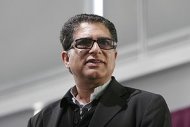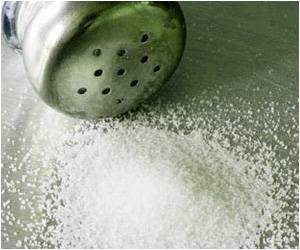 If anyone can apply the rules of science to the world of business, it’sDeepak Chopra. People have done a lot of work trying to understand business in terms of behavior and psychology, but Chopra goes deeper, applying the rules of biology, neuroscience(and maybe a little philosophy) to corporate leadership. I had the opportunity to sit down with Chopra for a few minutes before a recent event for his new book, The Soul of Leadership. He explained why it’s possible – even essential – to look to science to help people be better leaders.
If anyone can apply the rules of science to the world of business, it’sDeepak Chopra. People have done a lot of work trying to understand business in terms of behavior and psychology, but Chopra goes deeper, applying the rules of biology, neuroscience(and maybe a little philosophy) to corporate leadership. I had the opportunity to sit down with Chopra for a few minutes before a recent event for his new book, The Soul of Leadership. He explained why it’s possible – even essential – to look to science to help people be better leaders.You may have noticed that the word “soul” rather than “science” is in the title of his book, but not to worry. Chopra is quick to point out that there’s nothing particularly poetic or religious about his definition of soul. On the contrary, a soul is a person’s awareness, or consciousness, in its most attentive, unstressed form. Chopra explains that being in touch with the this kind of consciousness is what sports players, ballet dancers, and musicians experience when they enter a moment of utter connectedness with their art: the mind is clear, the world appears in slow motion, and all internal dialogue fades away. Long-time meditators commonly experience this state as well. Even better is that this state of consciousness can be witnessed in EEG recordings of the brain as a heightened, synchronous pattern of brain waves (called gamma synchrony).
This, says Chopra, is what soul is all about– and it is what leaders should strive to get in touch with as they lead their businesses and their teams. It may not sound so simple, but his new book outlines the steps one can take to get there (more on this below).
Today’s leadership, he says, is antiquated and broken, and it needs to reexamine itself. He proposes an interesting, certainly sciencey, way to think about the difference between bad and good leadership: The “leadership model today is based on predation, an old masculine thing: Conquer, defeat, win. It has worked, but its life cycle is over.” This classic, stress-mediated form of leadership is governed by the primitive midbrain, he says, the region charged with the “fight-or-flight” response. It has a certain strength, in a brute force kind of way, but it is hypersensitive, over-reactive, and needs to be re-envisioned.Given the archaic nature of present day leadership, Chopra says, it’s not surprising that the corporate world is crumbling from its own brawn. Chopra’s research with Gallup has shown that at least 65% of the U.S. workforce suffers from moderate to severe disengagement with their jobs: people who are “actively disengaged come to work with the express purpose of making other people unhappy.” These are serious signs that we need a new brand of leadership.The alternative, he says, is to go in a more conscious and “soulful” direction. This new variety of leadership is governed by more recently evolved and sophisticated areas of the brain. “The new model of leadership has to be more nurturing, more intuitive, more creative, more in line with feminine traits,” suggests Chopra. The gender analogy is interesting, but not in a war-of-the-genders kind of way. The bottom line is that a flexible, conscious form of leadership needs to replace the static, bulldozerish method of the present day. It just so happens that the traits that are needed are more in line with traditionally feminine qualities.He sums it up by explaining that, by nature, “all biological organisms are self-repairing, self-regulating systems.” The body and brain instinctively balance themselves when they get out of whack. Now, the same return to balance, or consciousness, needs to happen in business. Luckily, as more and more studies are finding, we can actively learn to shift our attention and become more conscious (soulful). When this shift or "rewiring" happens fully in corporate world, it will be in better shape.
Chopra points out that you don’t have to be an employer to make use of his The Soul of Leadership model. His theory uses business leadership as a framework, but it can be expand to promote leadership in every facet of life.
He uses the acronym LEADERS to illustrate his theory:
L = Look and Listen. Turning one’s awareness inward, and listening internally, can help one tap into profound sense of purpose.
E = Emotional Bonding. Strengthening supportive relationships with the self and others, rather than leading from “crisis mode” and negative reactivity, is crucial.
A = Awareness. A leader should always ask questions about herself/himself; this self-awareness will inspire the same thing in one’s team.
D = Doing. Leading proactively, but flexibly, is a necessary part of good business.
E = Empowerment. Being empowered means that one is receptive to feedback, but not mired by the opinions of other people.
R = Responsibility. Leaders need not only to make the best choices for themselves and their teams, but their biggest responsibility is inspiring greater consciousness in those around them.
S = Synchronicity. This enigmatic capacity is all about being in sync with the universe. People who “have the ability to create good luck and find invisible support” are tapping into the “universal field of consciousness,” says Chopra, which is a fundamental aspect of life.
Speaking of life, Chopra closed his talk by telling his audience to live it well and embrace it. It’s easier to see life’s beauty if you remember its brevity. “Look back at the prince of death behind you,” he says wryly. “Now look again, and he’s a little bit closer,” he adds with a chuckle. For a medicine man, his delivery is flawless.
By:By Alice G. Walton,Source:Forbes



